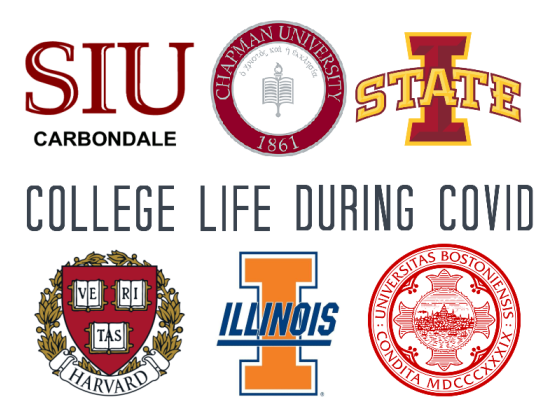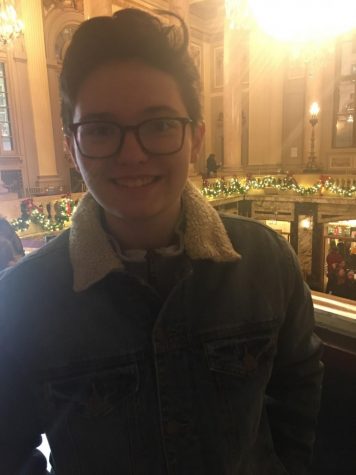College Life During a Global Pandemic

October 7, 2020
With fall quickly approaching, students across the country have started returning to school through Zoom calls, Google Meets, and controlled in-school classes. But for colleges in particular, there has been a lot of debate over whether or not it is safe to return to campus, prompting some students to opt out of in-person classes and work remotely instead.
The Chronicle, a leading newspaper focused on colleges and education, published an article detailing the Statistics of College Reopening Procedures. Only around 23% of the surveyed colleges are using a structure that is primarily in person, and even less -only 3.9% of colleges – are completely in person on campus. The most common campus procedures have been structures that are primarily online (34%) or some sort of hybrid schedule (21%).
For many of those who have been given the option to return to campus, their college experience has been completely altered. Now, with the added safety precautions accompanied by the standards of online learning, many have found the new “normal” to be isolating and abnormally restrictive. For many, this unconventional year started even before campus move-in day, and began when colleges first released their campus information.
“My university did not give us a lot of information on whether or not we would be going back,” said Natalie Snodgrass, a freshman at Chapman University in California. “They sent out the information last minute and gave us the decision of whether or not we would like to return to campus. For most students, including myself, this created a feeling of uncertainty. I didn’t know what the right decision would be.”
Litsa Kapsalis, a freshman at Harvard University, has found the return to campus to be alienating because of the limited access students have to buildings–truly an unusual contrast to the typical freshman year experience.
“All my classes are online so even though I’m on campus, I can’t enter any buildings except for my dorm and the dining hall to pick up food,” said Kapsalis. “This makes the experience more impersonal right off the bat.”
Katie Pierce, a sophomore at the University of Illinois, is one of the few students who has some classes in person.
“I am about 90% online,” said Pierce. “The only things I actually do in person are my strings class (half online, half in person, so I’m only going into the classroom once a week) and my ensemble, but even that is different.”
“It’s definitely weird not coming to campus and walking around as much,” said Emily Benz, a graduate student at Iowa State University. “It always looks so desolate, especially at times where in the past it would have been crowded during a passing period.”
The differences on campus aren’t just felt when it comes to classes, but are also evident through the lack of social events. A common feeling amongst many students is that it is significantly harder to meet new people and interact because of COVID restrictions and the cancellations of many extracurriculars.
“All of the groups [and] clubs either aren’t happening, or don’t know how they will work this year, or are only [using] zoom gatherings,” said Boston College freshman Abby Wickman. “Without these groups meeting, it has been really hard for me to find people who are like me.”
Due to the restrictions for the marching band, Pierce and her ensemble now only meet a fraction of the time that they would during an ordinary season.
“The Marching Illini made the tough decision to go virtual this year, which was a huge disappointment for our seniors and new members who were looking forward to a great season, especially coming off of our unexpected season in 2019,” said Pierce.
Others are missing out on the things that most excited them about college.
“The entire theatre season was cancelled, so ‘The Skriker’ from this past spring was likely my last ever academic show,” said Gracie Stockton, a senior at University of Minnesota. “I’ve worked in Theatre & Dance’s marketing department for a year and a half, which has now transitioned to video production of once in-person events.”
But despite all the resulting changes of the pandemic, students have found their own ways to relax and gain a sense of normalcy.
“My favorite thing to do on campus is to hang out in the lounge with people and play cards,” said Abby Wickman. “But I also really like setting up my hammock on different trees around campus and reading.”
Others, like Pierce, find solace in the consistency of schoolwork. “I just finished up a karaoke project (yep) for my music education technology course, and it was a blast!” said Pierce. “Projects like this have given me something to fill my quarantine time with.”
Though classes and extracurriculars are far from normal, the backbone of campus life is testing, and methods vary from campus to campus.
At the University of Illinois in Urbana-Champaign, testing is a constant part of a student’s life. Students are tested twice a week, and anyone entering a campus building will be denied access if they haven’t been tested for COVID. The tests are quick and efficient; with conclusive results given after 48 hours and giving students a sense of comfort.
“It has been so easy to get tested and get results, and it is one of the reasons I decided to come back to campus,” said Pierce. “I feel extremely safe knowing that I and others are being tested.”
At Boston College, their contact tracing depends largely upon self screening and social distancing. For Wickman, actual COVID tests are a little more uncommon than what would be preferable.
“The only thing I would change with how Boston College is handling COVID is more consistency with testing,” said Wickman. “I don’t think they’ve been doing enough tests since the initial test we took when we arrived.”
Other universities are not quite as diligent. At Southern Illinois University, weekly campus testing is optional for students on Mondays and Wednesdays.
“The only people who get routinely tested are student athletes,” said SIU freshman Meridith Hunt. According to Hunt, it is customary that if a student has symptoms, they should place a chair outside their dorm room and quarantine as a signal they may have contracted COVID.
There is no perfect solution about how college campuses should function right now, and like many aspects of life during the pandemic, it’s a work in progress. But with everything going on, perhaps we can find solace in the mindset of the nation’s college students.
“I think it has taught many students how to problem solve and make the best out of the situation we are in,” said Natalie Snodgrass.
In the face of all the doubts and questions about the pandemic, Wickman has chosen to remain optimistic about her school’s decision and is appreciative of their efforts.
“They are doing their best to give us the most normal experience without sacrificing the safety of students and staff,” said Wickman.
Their resilience remains an example that it’s not always about hoping for the ideal, but simply taking opportunities as they come and doing your best despite the hand you’ve been dealt.






